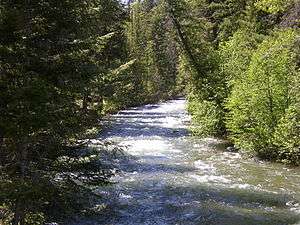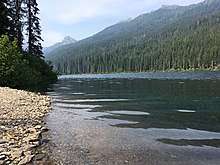Wenatchee National Forest
Wenatchee National Forest is a U.S. National Forest located in Washington. With an area of 1,735,394 acres (2,711.55 sq mi, or 7,022.89 km²), it extends about 137 miles along the eastern slopes of the Cascade Range of Washington, USA from Okanogan National Forest to Gifford Pinchot National Forest. The forest is located in Chelan, Kittitas and Yakima counties.
| Wenatchee National Forest | |
|---|---|
 Bumping River, Wenatchee National Forest | |
 | |
| Location | Washington, United States |
| Nearest city | Wenatchee, WA |
| Coordinates | 48.4°N 121°W |
| Area | 1,739,057 acres (7,037.71 km2)[1] |
| Established | July 1, 1908[2] |
| Governing body | U.S. Forest Service |
| Website | Okanogan-Wenatchee National Forest |
Wilderness areas
There are six officially designated wilderness areas within Wenatchee National Forest that are part of the National Wilderness Preservation System. All of them lie partially in neighboring National Forests (as indicated).
- Alpine Lakes Wilderness (partly in Snoqualmie NF)
- Glacier Peak Wilderness (partly in Mount Baker NF)
- Goat Rocks Wilderness (mostly in Gifford Pinchot NF)
- Henry M. Jackson Wilderness (partly in Snoqualmie NF (46.2%); Mount Baker NF (27.2%))
- Lake Chelan-Sawtooth Wilderness (mostly in Okanogan NF)
- William O. Douglas Wilderness (partly in Gifford Pinchot NF)
Waptus Lake

Nearly two miles long and accessible only by hiking or horse trails, Waptus Lake is the largest Alpine lake in the National Forest. Drained by the Waptus River, it is notable for its views of Summit Chief and Bears Breast mountains.
Administration
The Okanogan and Wenatchee National Forests are managed together as the Okanogan-Wenatchee National Forest with headquarters in Wenatchee, Washington. There are local ranger district offices located in Chelan, Cle Elum, Entiat, Methow Valley, Naches, Tonasket, and Wenatchee River. The first forest supervisor of Wenatchee National Forest was Albert H. Sylvester, who named over a thousand natural features in the region.
Ecology
A 1993 United States Forest Service study estimated that the extent of old growth in the Forest was 318,800 acres (129,000 ha).[3] Wildfires are not uncommon in the National Forest. In September 2012, a severe lightning storm ignited hundreds of fires, the largest of which were located southwest of the city of Wenatchee and east of Blewett Pass. Significant wildfires occurred again in July 2014, in the Chiwaukum and Entiat Mountains.[4] A lightning strike near Jolly Mountain on August 11, 2017 ultimately burned more than 38,000 acres and forced significant evacuations.[5]
References
- "Land Areas of the National Forest System" (PDF). U.S. Forest Service. January 2012. Retrieved June 30, 2012.
- "The National Forests of the United States" (PDF). ForestHistory.org. Archived from the original (PDF) on October 28, 2012. Retrieved July 30, 2012.
- Bolsinger, Charles L.; Waddell, Karen L. (1993), Area of old-growth forests in California, Oregon, and Washington (PDF), United States Forest Service, Pacific Northwest Research Station, Resource Bulletin PNW-RB-197
- Mapes, Lynda V. (July 23, 2015). "Collateral Damage: Rushing to stop a fire that never came, Forest Service logged miles of big trees, critical habitat". Seattle Times. Retrieved 23 July 2016.
- Bush, Evan (September 7, 2017). "Smoke? Fire? Destruction? The little towns near Lake Cle Elum have seen it before". Seattle Times. Retrieved 13 December 2017.
External links

- Okanogan-Wenatchee National Forest U.S. Forest Service
